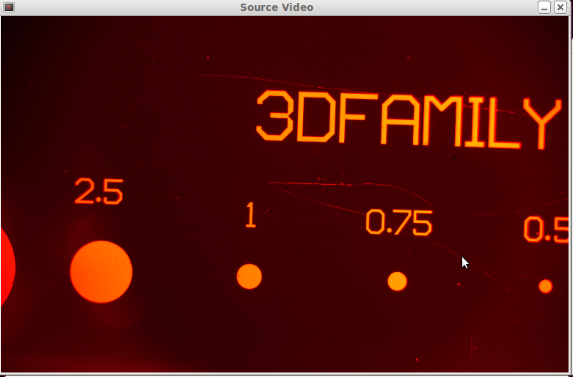上一篇文章中对IDS相机在windows下的开发做了基本介绍,本文介绍一下linux环境下IDS相机的二次开发。
首先,同样的在IDS官网下载相机的开发包https://en.ids-imaging.com/download-ueye-win64.html (需要注册后才可以下载)
在线手册:https://en.ids-imaging.com/manuals/uEye_SDK/ZH/uEye_Manual/index.html
当前版本为:
1.下载后得到文件:uEye-Linux-4.72-32-bit.tgz
解压该压缩包后得到3个文件:
2.选择对应相机的开发包进行安装,我用的是USB相机,故选择第3个文件。
(在安装之前,需要先配置环境,具体环境要求在第一个ReadMe文件中有说明)
安装命令:
sudo chmod +x ueyesdk-setup-4.72-usb-i686.gz.run
sudo ueyesdk-setup-4.72-usb-i686.gz.run
执行该命令后开始安装sdk
sudo /etc/init.d/ueyeusbdrc start
若正确安装,输入上述命令后相机指示灯变绿
3.打开相机
使用使用sdk中提供的管理工具打开相机,在终端输入命令:
sudo '/usr/local/share/ueye/bin/idscameramanager'
得到如下画面:列表框中显示了当前所连接的相机,双击或右键选择打开相机。
得到相机画面如下。
( sdk提供了该程序的源码,放在/usr/src/ids 目录下,程序是用Qt写的)
好了,环境搭建成功,开始进行二次开发。
linux环境下我选用了QT作为开发工具。新建一个Qt纯C++项目,并将IDS相机封装成一个C++类,方便调用。
QT的pro文件如下:
TEMPLATE = app
CONFIG += console
CONFIG -= qt
SOURCES += main.cpp \
idscam.cpp
HEADERS += \
idscam.h
!win32 {
DEFINES += __LINUX__
LIBS += -lueye_api
}
win32 {
## Windows common build
!contains(QMAKE_TARGET.arch, x86_64) {
## Windows x86 (32bit) specific build
LIBS += -lueye_api
} else {
## Windows x64 (64bit) specific build
LIBS += -lueye_api_64
}
}
INCLUDEPATH += /usr/include/opencv/OpenCV-2.3.1/include/opencv2\
/usr/include/opencv/OpenCV-2.3.1/include/opencv\
/usr/include/opencv/OpenCV-2.3.1/include
LIBS += /usr/include/opencv/OpenCV-2.3.1/release/lib/libopencv_highgui.so \
/usr/include/opencv/OpenCV-2.3.1/release/lib/libopencv_core.so \
/usr/include/opencv/OpenCV-2.3.1/release/lib/libopencv_imgproc.so \这里需要注意的是:
为了访问相机,必须包含如下文件:
•头文件:ueye.h
•库:libueye_api.so
相机类头文件为:
#ifndef IDSCAM_H
#define IDSCAM_H
#include <uEye.h>
#include <cv.h>
#include <highgui.h>
#include <semaphore.h>
class Idscam
{
public:
Idscam();
~Idscam();
bool Init();
//1.初始化相机 hWnd指向显示图像窗口的指针,若用DIB模式可以令hWnd=NULL
INT InitCamera (HIDS *hCam, HWND hWnd);
bool OpenCamera();
void ExitCamera();
int InitDisplayMode();
void GetMaxImageSize(INT *pnSizeX, INT *pnSizeY);
bool GetiplImgFormMem();
// uEye varibles
HIDS m_hCam; // 相机句柄
HWND m_hWndDisplay; // window显示句柄
INT m_nColorMode; // Y8/RGB16/RGB24/REG32
INT m_nBitsPerPixel; // 图像位深
INT m_nSizeX; // width of image
INT m_nSizeY; // height of image
IplImage *iplImg;
char *m_pLastBuffer;
int getImage(IplImage *image);
void cam_stop();
bool stop;
protected:
int camIndex;
int resWidth;
int resHeight;
int blackLevel, gain, exposureTime;//定义曝光时间等等
sem_t sem;
private:
void startthread();
static void *video_capture_thread(void *arg);
pthread_t m_thread;
// 使用位图模式进行实时显示需要的内存
INT m_lMemoryId; // camera memory - buffer ID
char* m_pcImageMemory; // camera memory - pointer to buffer
SENSORINFO m_sInfo; // sensor information struct
};
#endif // IDSCAM_H实现为:
#include "idscam.h"
#include <string>
#include <iostream>
#include <stdio.h>
using namespace std;
Idscam::Idscam(){
//初始化相机相关参数
m_pcImageMemory = NULL;
m_lMemoryId = 0;
m_hCam = 0; //初始化相机句柄为0
iplImg=cvCreateImageHeader( cvSize(1936,1216),8,4 );
stop = false;
if (!Init()){
cerr << "cannot init camera!" << endl;
}
else{
startthread();
}
}
bool Idscam::Init()
{
if(OpenCamera()){
sem_init(&sem, 0,1);
return true;
}
else
return false;
}
bool Idscam::OpenCamera(){
INT nRet = IS_NO_SUCCESS; //参数先赋初始值
ExitCamera(); //
m_hCam = (HIDS) 0;
nRet = InitCamera(&m_hCam, m_hWndDisplay); // 1.初始化相机
if (nRet == IS_SUCCESS) // 打开相机成功
{
// 查询相机所用传感器的类型
is_GetSensorInfo(m_hCam, &m_sInfo); //2.查询信息
GetMaxImageSize(&m_nSizeX, &m_nSizeY);
nRet = InitDisplayMode(); //3.选择显示模式(位图)
if (nRet == IS_SUCCESS)
{
INT num= is_CaptureVideo( m_hCam, IS_WAIT ); //4.设定捕捉模式:自由运行模式下的实时模式
return true;
}
else{
printf("Init the camera displayMode error !\n");
return false;
}
}
else
{
printf("cannot find uEye camra !\n");
return false;
}
}
void Idscam::startthread(){
int res=pthread_create(&m_thread, NULL, video_capture_thread,(void*)this);
}
void Idscam::cam_stop(){
stop=true;
ExitCamera();//释放内存;
pthread_exit;
}
void* Idscam::video_capture_thread(void *arg){
Idscam *came=(Idscam *)arg;
while(!came->stop)
{
came->GetiplImgFormMem(); //实时获取图像
usleep(300); //需要加等待,不然会很耗CPU
}
}
Idscam::~Idscam()
{
cam_stop();
}
int Idscam::getImage(IplImage *image){
if(image->width==iplImg->width && image->height==iplImg->height){
sem_wait(&sem);
cvCopy(iplImg, image); //从相机缓存中获取当前画面
sem_post(&sem);
return 0;
}
return -1;
}
void Idscam:: ExitCamera()
{
if( m_hCam != 0 ) // 如果找到相机
{
// 在曝光未开始时停止实时模式或取消硬件触发的图像捕捉
is_StopLiveVideo( m_hCam, IS_WAIT );
// 释放分配的图像内存
if( m_pcImageMemory != NULL )
is_FreeImageMem( m_hCam, m_pcImageMemory, m_lMemoryId );
m_pcImageMemory = NULL;
// 关闭相机
is_ExitCamera( m_hCam );
m_hCam = NULL;
}
}
//1.初始化相机
INT Idscam::InitCamera (HIDS *hCam, HWND hWnd)
{
INT nRet = is_InitCamera (hCam, hWnd);
/************************************************************************************************/
/* 若相机返回 "IS_STARTER_FW_UPLOAD_NEEDED"表明相机的启动程序固件和驱动不兼容,需要更新固件版本 */
/* 这将占用一段时间,可以用 is_GetDuration()来进行该过程的时间预估。 */
/************************************************************************************************/
if (nRet == IS_STARTER_FW_UPLOAD_NEEDED)
{
// Time for the firmware upload = 25 seconds by default
INT nUploadTime = 25000;
is_GetDuration (*hCam, IS_STARTER_FW_UPLOAD, &nUploadTime);
printf("This camera requires a new firmware !\n");
printf("The upload will take about %f seconds. Please wait ...\n",nUploadTime/1000);
//再次打开相机并自动更新固件
*hCam = (HIDS) (((INT)*hCam) | IS_ALLOW_STARTER_FW_UPLOAD);
nRet = is_InitCamera (hCam, NULL);
}
return nRet;
}
int Idscam::InitDisplayMode()
{
INT nRet = IS_NO_SUCCESS;
if (m_hCam == NULL)
return IS_NO_SUCCESS;
if (m_pcImageMemory != NULL) //释放通过 is_AllocImageMem() 函数分配的图像内存
{
printf("m_pcImageMemory != NULL\n");
is_FreeImageMem( m_hCam, m_pcImageMemory, m_lMemoryId );
//如果图像内存不是通过SDK分配,则需调用 is_FreeImageMem() 函数。否则驱动会继续尝试访问该内存。
//但是这并不能释放内存。因此,必须确保可再次释放内存。
}
m_pcImageMemory = NULL;
// 设置位图模式
nRet = is_SetDisplayMode(m_hCam, IS_SET_DM_DIB);
if (m_sInfo.nColorMode == IS_COLORMODE_BAYER)
{
// setup the color depth to the current windows setting
// is_GetColorDepth(m_hCam, &m_nBitsPerPixel, &m_nColorMode);
m_nColorMode = IS_CM_BGRA8_PACKED;
m_nBitsPerPixel = 32;
printf("m_nBitsPerPixel m_nColorMode is %d,%d\n",m_nBitsPerPixel,m_nColorMode);
}
else if (m_sInfo.nColorMode == IS_COLORMODE_CBYCRY)
{
printf("for color camera models use RGB32 mode\n");
// for color camera models use RGB32 mode
m_nColorMode = IS_CM_BGRA8_PACKED;
m_nBitsPerPixel = 32;
}
else
{
printf("for monochrome camera models use Y8 mode\n");
// for monochrome camera models use Y8 mode
m_nColorMode = IS_CM_MONO8;
m_nBitsPerPixel = 8;
}
// 分配图像内存,图像尺寸有 m_nSizeX和m_nSizeY确定,色彩位深由m_nBitsPerPixel确定,m_pcImageMemory返回起始地址,m_lMemoryId 返回已分配内存的ID
if (is_AllocImageMem(m_hCam, m_nSizeX, m_nSizeY, m_nBitsPerPixel, &m_pcImageMemory, &m_lMemoryId ) != IS_SUCCESS)
{
printf("相机内存分配出错!\n");
std::cout<<"5 m_hCam is "<<m_hCam<<std::endl;
}
else //激活该图像内存,图像数据(DIB模式)便存储在此内存中
is_SetImageMem( m_hCam, m_pcImageMemory, m_lMemoryId );
printf("分配图像内存\n");
/* INT is_SetImageMem (HIDS hCam, char* pcImgMem, INT id)用于将指定的图像内存变为活动内存。
只有活动图像内存可以接收图像数据。
在调用 is_FreezeVideo() 时,捕捉的图像会存储在 pcImgMem 和 id 指定的图像缓冲区中。
捕捉的图像会存储在 pcImgMem 和 id 指定的图像缓冲区中。对于 pcImgMem,
您必须传递 is_AllocImageMem() 创建的指针,传递任何其他指针均会发出错误信息。
您可以多次传递同样的指针。 */
if (nRet == IS_SUCCESS)
{
printf("设置显卡在保存或显示图像数据时所使用的色彩模\n");
// 设置显卡在保存或显示图像数据时所使用的色彩模
is_SetColorMode(m_hCam, m_nColorMode);
// set the image size to capture
IS_SIZE_2D imageSize;
imageSize.s32Width = m_nSizeX;
imageSize.s32Height = m_nSizeY;
//设置图像感兴趣区域(AOI)的大小和位置
is_AOI(m_hCam, IS_AOI_IMAGE_SET_SIZE, (void*)&imageSize, sizeof(imageSize));
}
std::cout<<"InitDisplayMode nRet is "<<nRet<<std::endl;
return nRet;
}
void Idscam::GetMaxImageSize(INT *pnSizeX, INT *pnSizeY)
{
// Check if the camera supports an arbitrary AOI
// Only the ueye xs does not support an arbitrary AOI
INT nAOISupported = 0;
BOOL bAOISupported = TRUE;
if (is_ImageFormat(m_hCam,
IMGFRMT_CMD_GET_ARBITRARY_AOI_SUPPORTED,
(void*)&nAOISupported,
sizeof(nAOISupported)) == IS_SUCCESS)
{
bAOISupported = (nAOISupported != 0);
}
if (bAOISupported)
{
// All other sensors
// Get maximum image size
SENSORINFO sInfo;
is_GetSensorInfo (m_hCam, &sInfo);
*pnSizeX = sInfo.nMaxWidth;
*pnSizeY = sInfo.nMaxHeight;
}
else
{
// Only ueye xs
// Get image size of the current format
IS_SIZE_2D imageSize;
is_AOI(m_hCam, IS_AOI_IMAGE_GET_SIZE, (void*)&imageSize, sizeof(imageSize));
*pnSizeX = imageSize.s32Width;
*pnSizeY = imageSize.s32Height;
}
}
bool Idscam::GetiplImgFormMem(){ //实时获取图像时需要不断刷新此函数
if(!m_hCam) return false;
char *pLast = NULL, *pMem = NULL;
INT dummy = 0;
//确定当前用于捕捉图像的图像内存 pMem,最后一个用于捕捉图像的图像内存pLast
is_GetActSeqBuf (m_hCam, &dummy, &pMem, &pLast);
m_pLastBuffer = pLast;
if (m_pLastBuffer)
{
iplImg->imageData = m_pLastBuffer; //将图像首地址传给iplImg
return true;
}
else
return false;
}
主程序为:
这里使用了死循环不断调用相机,在实际运行时,程序跑一会就会被杀死。
#include "idscam.h"
#include <iostream>
#include <cv.h>
#include <highgui.h>
using namespace std;
char* window_name = "Source Video";
int main()
{
Idscam *mycam;
mycam = new Idscam();
IplImage *dst;
IplImage *pic;
float scale = 0.4; //缩放倍数为0.4倍 相机原画面为 1936 x 1216
CvSize pic_cvsize; //目标图像尺寸
while(1){
if(mycam->GetiplImgFormMem()){
dst = cvCloneImage(mycam->iplImg);
pic_cvsize.width = dst->width * scale; //目标图像的宽为源图象宽的scale倍
pic_cvsize.height= dst->height * scale; //目标图像的高为源图象高的scale倍
pic = cvCreateImage(pic_cvsize,dst->depth,dst->nChannels); //构造目标图象
cvResize(dst,pic,CV_INTER_LINEAR); //缩放源图像到目标图像
cvShowImage(window_name,pic);
if(cvWaitKey(300)==27){
mycam->cam_stop();
return 0;
}
}
}
return 0;
}
运行后得到相机实时画面:
项目源代码戳这里。



























 2118
2118

 被折叠的 条评论
为什么被折叠?
被折叠的 条评论
为什么被折叠?








